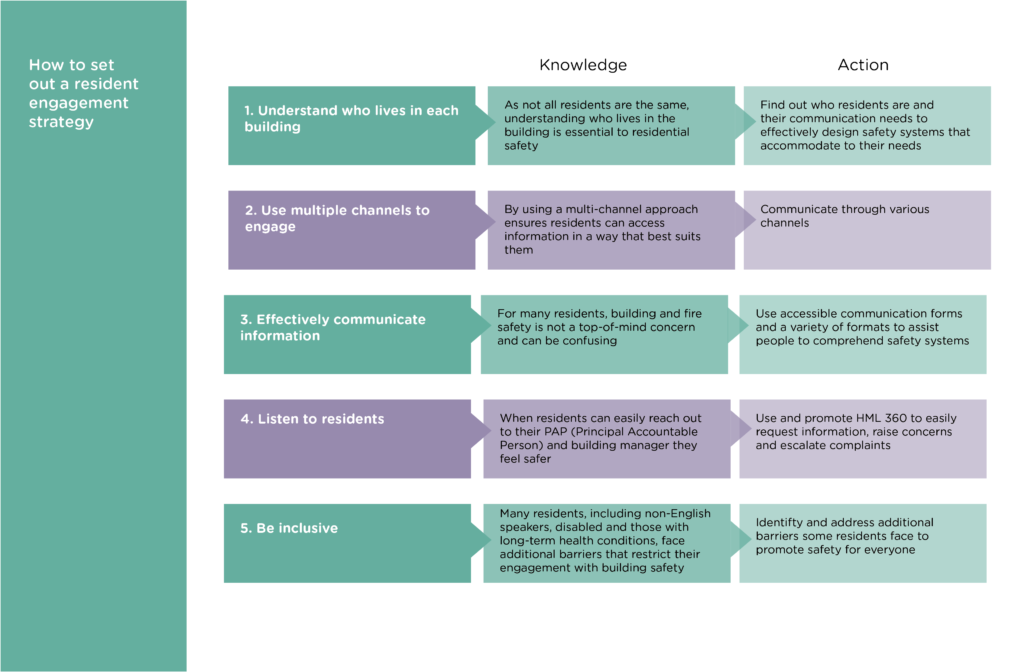Since October 2023, a significant element to the safety case report is the resident’s engagement strategy, a core principle of the Building Safety Act.
Submitted as part of the building assessment certificate, the resident engagement strategy is a core principle of the Building Safety Act to ensure those responsible for buildings engage with residents on safety matters. As residents play a core role in managing the safety elements of their building, the strategy is essential for capturing their observations and concerns.
The Principle Accountable Persons (PAP) must provide resident specific information to justify their building safety decisions. This is defined as any decision made by an accountable person about the management of the building, the management of building safety risks or any other decision connected to the duties of an accountable person.
Each PAP must submit a resident engagement strategy to establish out how residents and owners over the age of 16 should be consulted on building safety decisions. The strategy should also be proportionate to the needs of the building and its’ residents. To ensure that residents safety concerns are heard and recorded, the strategy should mention a separate complaints process, especially relating to the fire and structural safety of the building.
Legal duties
To comply with legal requirements, the PAP must:
- Prepare a resident engagement strategy
- Act in accordance with the strategy
- Review and revise the strategy and keep a record of the reviews
- Provide the latest version to each accountable person when necessary, consult residents, owners of residential units, and accountable persons about the strategy and take their opinions into account
The strategy becomes eligible from when the building is or becomes occupied and when a PAP is appointed.

What must the resident engagement strategy cover?
This should include information on the decisions you are asking for opinions on, in addition to feedback on where and when the work will be conducted. Sometimes you only need to ask residents and residential unit owners about specific parts of a decision that may affect them. For example, if work is required to fix a faulty fire door, inquiring about the task may be unnecessary. However, you may ask residents who may be impacted by the operations when the ideal time would be to complete the repair and how else interruptions may be minimised.
how to collect and use opinions
Potential methods to collect and utilise opinions of residents and owners of residential units include:
- postal letters or surveys
- a website, emails, social media, or apps
- meetings or visits
According to the 2010 Equality Act, there is a responsibility to ensure there is no discrimination due to inaccessible information and underpins the fire safety legislation that all people can leave a building safely in the event of a fire. Therefore, it should be clear you have considered different communication needs such as additional languages and alternative formats for example, large text, easy read, braille or audio.
A housing association have used a mixture of individual appointments, email, post and telephone calls to successfully achieve high engagement with an 82% response rate. To see some examples for accommodating to people’s different communication needs, click here.
Participants should also be informed of the following:
- describe the method for gathering, reviewing and acting on opinions
- explain your approach to receiving feedback and making adjustments based on it
- the amount of time residents and owners have to provide feedback and explain the timeline
- ensure GDPR compliance when collecting and storing information
How to measure and review participation
There are varying ways to assess the success of the strategy which should be conducted regularly after each action has been taken, such as:
- record how many responses are received when you ask about a building safety decision
- use surveys and focus groups
- set up meetings and visits
If the results demonstrate a lack of satisfaction or little participation, you may need to adjust your strategy.
After you have prepared your resident engagement strategy
Once the strategy has been completed, the accountable persons must provide a new version of the strategy each time; a date and version will help to keep track. Each consultation period must be a minimum of 3 weeks and stated in the strategy.
If the building is new and residents are yet to move in, a staggered approach may be the most appropriate.
A review of the strategy must be conducted every two years and after:
- every consultation of the strategy
- a mandatory occurrence report
- the completion of significant material alterations to the building
How can HML help?
The resident engagement strategy will form part of the building safety case file and will be developed in tandem to it. The regulator does acknowledge that not every resident is going to be active with the management of their building safety. So long as the PAP can demonstrate they’re taking reasonable steps to engage on all relevant building safety matters, they will have fulfilled their duty.